Analyzing the Social Ecological Model's Impact on Adolescent Health
VerifiedAdded on 2023/04/22
|6
|1458
|81
Report
AI Summary
This report explores the Social Ecological Model (SEM) and its application to adolescent health, emphasizing the interplay of individual, social, and environmental factors. It outlines the SEM's five dynamic components: intrapersonal, interpersonal, community, organizational, and policy levels. The report discusses how the SEM framework addresses health literacy and promotes interventions at various levels, including intrapersonal components like knowledge and skills, interpersonal elements like social support, and community-level approaches. Furthermore, it highlights challenges such as structural racism, economic hardship, and targeted marketing, which impede health equity. The report concludes by advocating for systemic changes, health education, and community involvement to empower adolescents and promote better health outcomes.
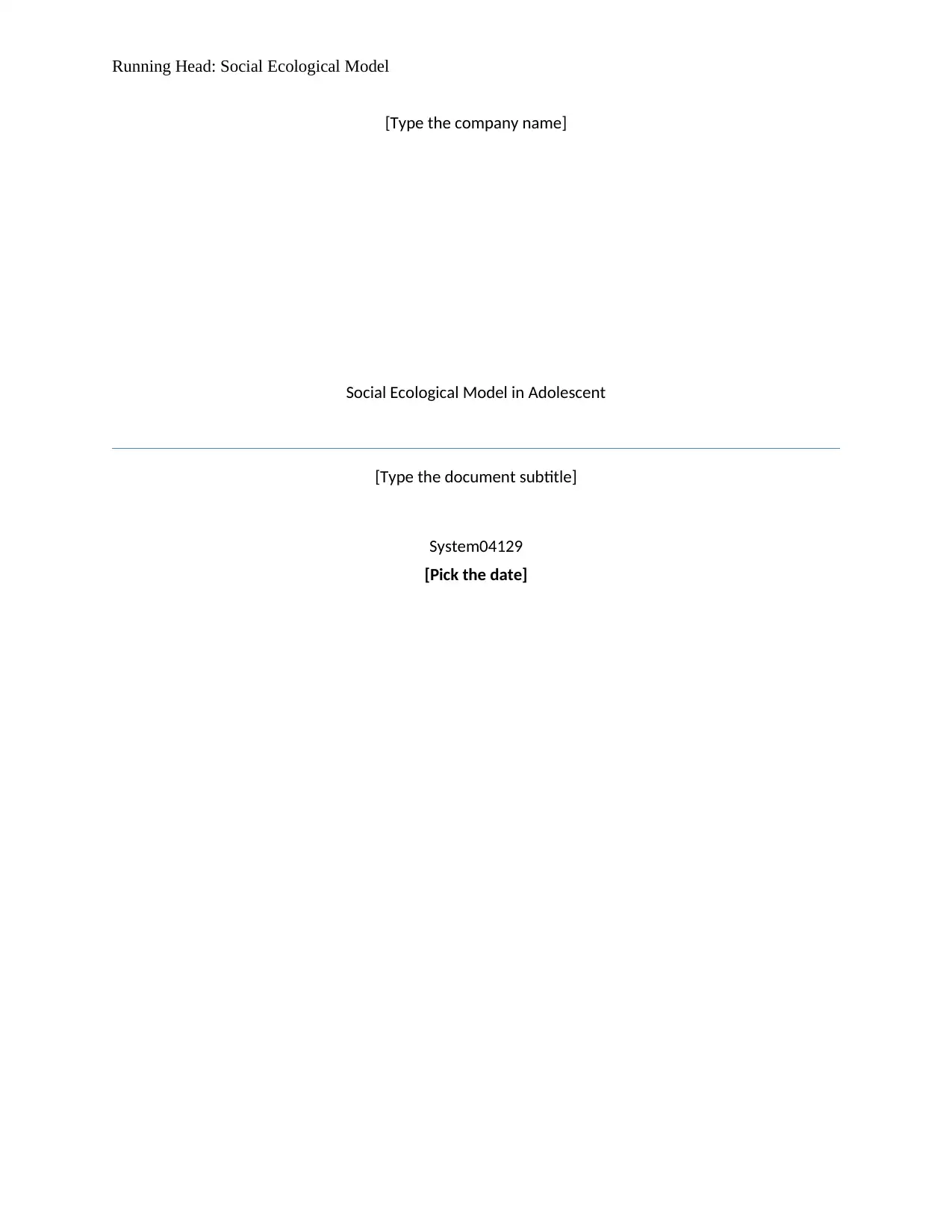
Running Head: Social Ecological Model
[Type the company name]
Social Ecological Model in Adolescent
[Type the document subtitle]
System04129
[Pick the date]
[Type the company name]
Social Ecological Model in Adolescent
[Type the document subtitle]
System04129
[Pick the date]
Paraphrase This Document
Need a fresh take? Get an instant paraphrase of this document with our AI Paraphraser
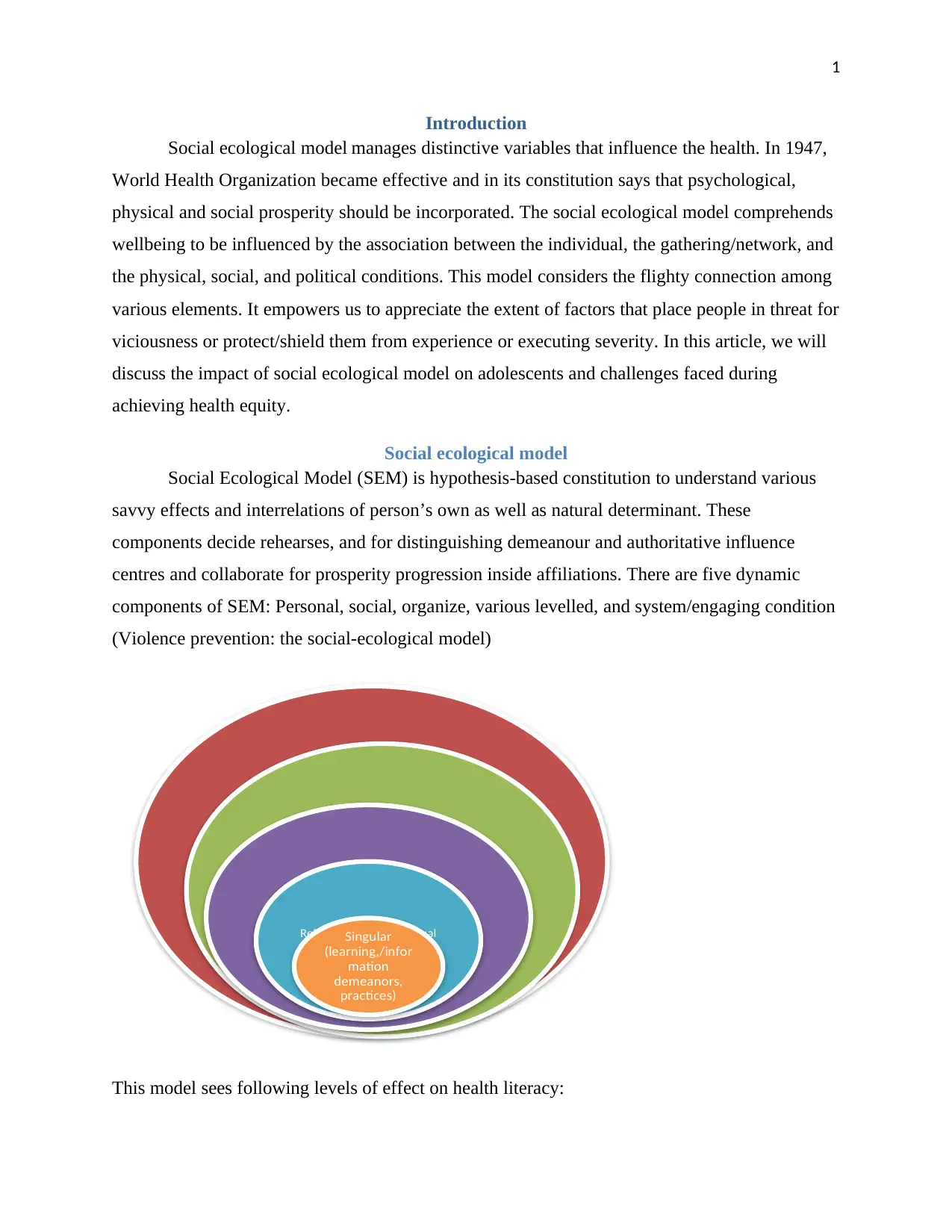
1
Introduction
Social ecological model manages distinctive variables that influence the health. In 1947,
World Health Organization became effective and in its constitution says that psychological,
physical and social prosperity should be incorporated. The social ecological model comprehends
wellbeing to be influenced by the association between the individual, the gathering/network, and
the physical, social, and political conditions. This model considers the flighty connection among
various elements. It empowers us to appreciate the extent of factors that place people in threat for
viciousness or protect/shield them from experience or executing severity. In this article, we will
discuss the impact of social ecological model on adolescents and challenges faced during
achieving health equity.
Social ecological model
Social Ecological Model (SEM) is hypothesis-based constitution to understand various
savvy effects and interrelations of person’s own as well as natural determinant. These
components decide rehearses, and for distinguishing demeanour and authoritative influence
centres and collaborate for prosperity progression inside affiliations. There are five dynamic
components of SEM: Personal, social, organize, various levelled, and system/engaging condition
(Violence prevention: the social-ecological model)
This model sees following levels of effect on health literacy:
Approche (laws)
Definitive(affiliations and social associations )
Community (connections between
associations)
Relational (families, casual
association)
Singular
(learning,/infor
mation
demeanors,
practices)
Introduction
Social ecological model manages distinctive variables that influence the health. In 1947,
World Health Organization became effective and in its constitution says that psychological,
physical and social prosperity should be incorporated. The social ecological model comprehends
wellbeing to be influenced by the association between the individual, the gathering/network, and
the physical, social, and political conditions. This model considers the flighty connection among
various elements. It empowers us to appreciate the extent of factors that place people in threat for
viciousness or protect/shield them from experience or executing severity. In this article, we will
discuss the impact of social ecological model on adolescents and challenges faced during
achieving health equity.
Social ecological model
Social Ecological Model (SEM) is hypothesis-based constitution to understand various
savvy effects and interrelations of person’s own as well as natural determinant. These
components decide rehearses, and for distinguishing demeanour and authoritative influence
centres and collaborate for prosperity progression inside affiliations. There are five dynamic
components of SEM: Personal, social, organize, various levelled, and system/engaging condition
(Violence prevention: the social-ecological model)
This model sees following levels of effect on health literacy:
Approche (laws)
Definitive(affiliations and social associations )
Community (connections between
associations)
Relational (families, casual
association)
Singular
(learning,/infor
mation
demeanors,
practices)
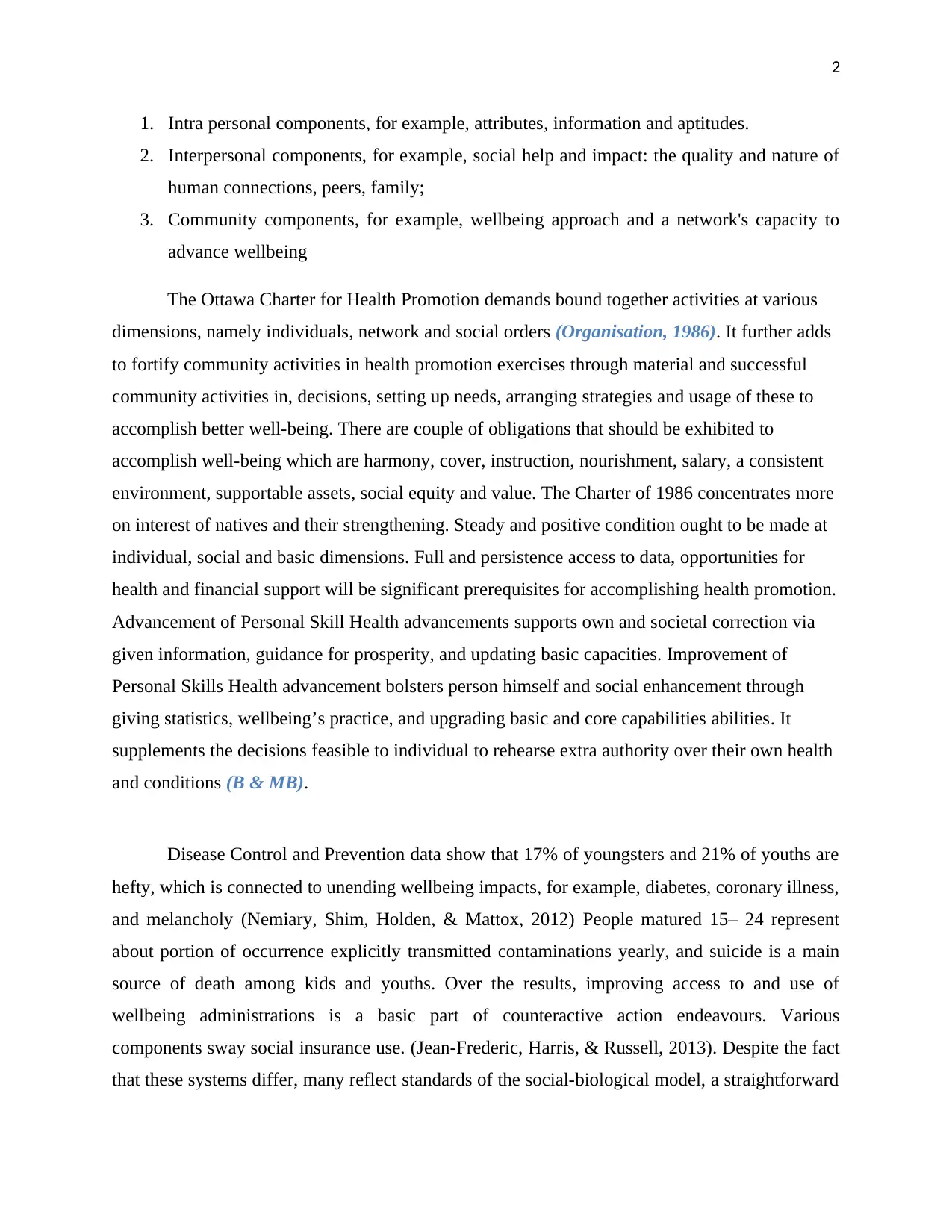
2
1. Intra personal components, for example, attributes, information and aptitudes.
2. Interpersonal components, for example, social help and impact: the quality and nature of
human connections, peers, family;
3. Community components, for example, wellbeing approach and a network's capacity to
advance wellbeing
The Ottawa Charter for Health Promotion demands bound together activities at various
dimensions, namely individuals, network and social orders (Organisation, 1986). It further adds
to fortify community activities in health promotion exercises through material and successful
community activities in, decisions, setting up needs, arranging strategies and usage of these to
accomplish better well-being. There are couple of obligations that should be exhibited to
accomplish well-being which are harmony, cover, instruction, nourishment, salary, a consistent
environment, supportable assets, social equity and value. The Charter of 1986 concentrates more
on interest of natives and their strengthening. Steady and positive condition ought to be made at
individual, social and basic dimensions. Full and persistence access to data, opportunities for
health and financial support will be significant prerequisites for accomplishing health promotion.
Advancement of Personal Skill Health advancements supports own and societal correction via
given information, guidance for prosperity, and updating basic capacities. Improvement of
Personal Skills Health advancement bolsters person himself and social enhancement through
giving statistics, wellbeing’s practice, and upgrading basic and core capabilities abilities. It
supplements the decisions feasible to individual to rehearse extra authority over their own health
and conditions (B & MB).
Disease Control and Prevention data show that 17% of youngsters and 21% of youths are
hefty, which is connected to unending wellbeing impacts, for example, diabetes, coronary illness,
and melancholy (Nemiary, Shim, Holden, & Mattox, 2012) People matured 15– 24 represent
about portion of occurrence explicitly transmitted contaminations yearly, and suicide is a main
source of death among kids and youths. Over the results, improving access to and use of
wellbeing administrations is a basic part of counteractive action endeavours. Various
components sway social insurance use. (Jean-Frederic, Harris, & Russell, 2013). Despite the fact
that these systems differ, many reflect standards of the social-biological model, a straightforward
1. Intra personal components, for example, attributes, information and aptitudes.
2. Interpersonal components, for example, social help and impact: the quality and nature of
human connections, peers, family;
3. Community components, for example, wellbeing approach and a network's capacity to
advance wellbeing
The Ottawa Charter for Health Promotion demands bound together activities at various
dimensions, namely individuals, network and social orders (Organisation, 1986). It further adds
to fortify community activities in health promotion exercises through material and successful
community activities in, decisions, setting up needs, arranging strategies and usage of these to
accomplish better well-being. There are couple of obligations that should be exhibited to
accomplish well-being which are harmony, cover, instruction, nourishment, salary, a consistent
environment, supportable assets, social equity and value. The Charter of 1986 concentrates more
on interest of natives and their strengthening. Steady and positive condition ought to be made at
individual, social and basic dimensions. Full and persistence access to data, opportunities for
health and financial support will be significant prerequisites for accomplishing health promotion.
Advancement of Personal Skill Health advancements supports own and societal correction via
given information, guidance for prosperity, and updating basic capacities. Improvement of
Personal Skills Health advancement bolsters person himself and social enhancement through
giving statistics, wellbeing’s practice, and upgrading basic and core capabilities abilities. It
supplements the decisions feasible to individual to rehearse extra authority over their own health
and conditions (B & MB).
Disease Control and Prevention data show that 17% of youngsters and 21% of youths are
hefty, which is connected to unending wellbeing impacts, for example, diabetes, coronary illness,
and melancholy (Nemiary, Shim, Holden, & Mattox, 2012) People matured 15– 24 represent
about portion of occurrence explicitly transmitted contaminations yearly, and suicide is a main
source of death among kids and youths. Over the results, improving access to and use of
wellbeing administrations is a basic part of counteractive action endeavours. Various
components sway social insurance use. (Jean-Frederic, Harris, & Russell, 2013). Despite the fact
that these systems differ, many reflect standards of the social-biological model, a straightforward
⊘ This is a preview!⊘
Do you want full access?
Subscribe today to unlock all pages.

Trusted by 1+ million students worldwide
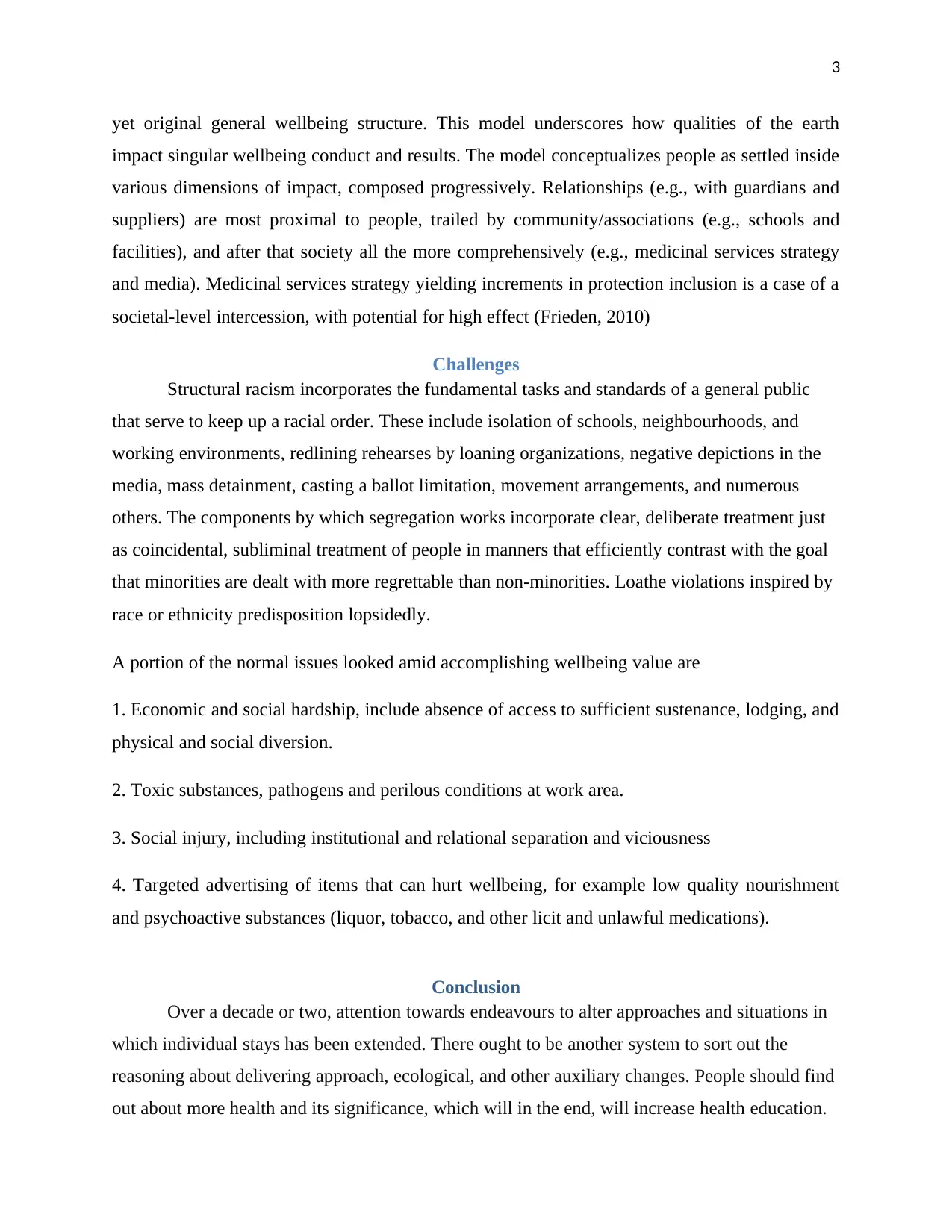
3
yet original general wellbeing structure. This model underscores how qualities of the earth
impact singular wellbeing conduct and results. The model conceptualizes people as settled inside
various dimensions of impact, composed progressively. Relationships (e.g., with guardians and
suppliers) are most proximal to people, trailed by community/associations (e.g., schools and
facilities), and after that society all the more comprehensively (e.g., medicinal services strategy
and media). Medicinal services strategy yielding increments in protection inclusion is a case of a
societal-level intercession, with potential for high effect (Frieden, 2010)
Challenges
Structural racism incorporates the fundamental tasks and standards of a general public
that serve to keep up a racial order. These include isolation of schools, neighbourhoods, and
working environments, redlining rehearses by loaning organizations, negative depictions in the
media, mass detainment, casting a ballot limitation, movement arrangements, and numerous
others. The components by which segregation works incorporate clear, deliberate treatment just
as coincidental, subliminal treatment of people in manners that efficiently contrast with the goal
that minorities are dealt with more regrettable than non-minorities. Loathe violations inspired by
race or ethnicity predisposition lopsidedly.
A portion of the normal issues looked amid accomplishing wellbeing value are
1. Economic and social hardship, include absence of access to sufficient sustenance, lodging, and
physical and social diversion.
2. Toxic substances, pathogens and perilous conditions at work area.
3. Social injury, including institutional and relational separation and viciousness
4. Targeted advertising of items that can hurt wellbeing, for example low quality nourishment
and psychoactive substances (liquor, tobacco, and other licit and unlawful medications).
Conclusion
Over a decade or two, attention towards endeavours to alter approaches and situations in
which individual stays has been extended. There ought to be another system to sort out the
reasoning about delivering approach, ecological, and other auxiliary changes. People should find
out about more health and its significance, which will in the end, will increase health education.
yet original general wellbeing structure. This model underscores how qualities of the earth
impact singular wellbeing conduct and results. The model conceptualizes people as settled inside
various dimensions of impact, composed progressively. Relationships (e.g., with guardians and
suppliers) are most proximal to people, trailed by community/associations (e.g., schools and
facilities), and after that society all the more comprehensively (e.g., medicinal services strategy
and media). Medicinal services strategy yielding increments in protection inclusion is a case of a
societal-level intercession, with potential for high effect (Frieden, 2010)
Challenges
Structural racism incorporates the fundamental tasks and standards of a general public
that serve to keep up a racial order. These include isolation of schools, neighbourhoods, and
working environments, redlining rehearses by loaning organizations, negative depictions in the
media, mass detainment, casting a ballot limitation, movement arrangements, and numerous
others. The components by which segregation works incorporate clear, deliberate treatment just
as coincidental, subliminal treatment of people in manners that efficiently contrast with the goal
that minorities are dealt with more regrettable than non-minorities. Loathe violations inspired by
race or ethnicity predisposition lopsidedly.
A portion of the normal issues looked amid accomplishing wellbeing value are
1. Economic and social hardship, include absence of access to sufficient sustenance, lodging, and
physical and social diversion.
2. Toxic substances, pathogens and perilous conditions at work area.
3. Social injury, including institutional and relational separation and viciousness
4. Targeted advertising of items that can hurt wellbeing, for example low quality nourishment
and psychoactive substances (liquor, tobacco, and other licit and unlawful medications).
Conclusion
Over a decade or two, attention towards endeavours to alter approaches and situations in
which individual stays has been extended. There ought to be another system to sort out the
reasoning about delivering approach, ecological, and other auxiliary changes. People should find
out about more health and its significance, which will in the end, will increase health education.
Paraphrase This Document
Need a fresh take? Get an instant paraphrase of this document with our AI Paraphraser
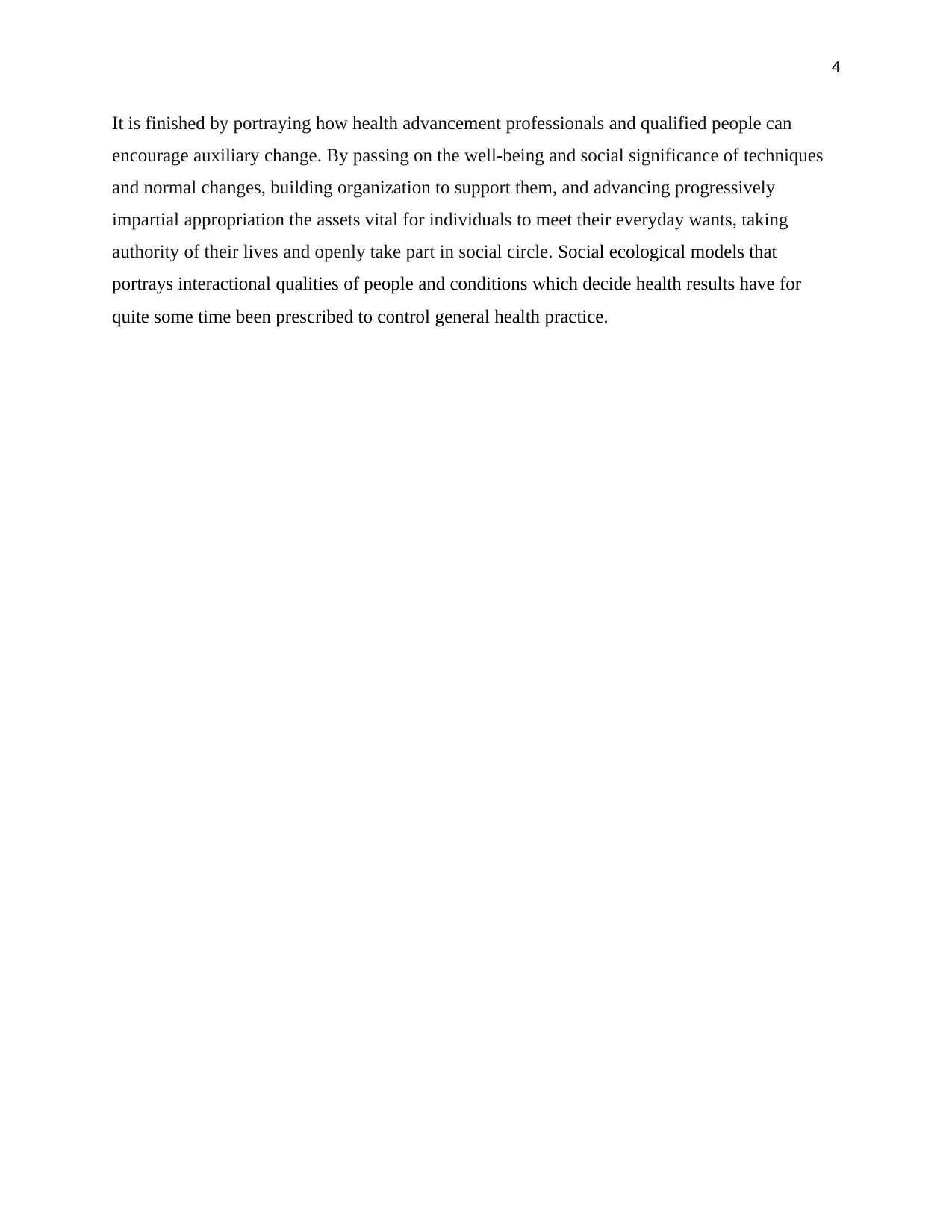
4
It is finished by portraying how health advancement professionals and qualified people can
encourage auxiliary change. By passing on the well-being and social significance of techniques
and normal changes, building organization to support them, and advancing progressively
impartial appropriation the assets vital for individuals to meet their everyday wants, taking
authority of their lives and openly take part in social circle. Social ecological models that
portrays interactional qualities of people and conditions which decide health results have for
quite some time been prescribed to control general health practice.
It is finished by portraying how health advancement professionals and qualified people can
encourage auxiliary change. By passing on the well-being and social significance of techniques
and normal changes, building organization to support them, and advancing progressively
impartial appropriation the assets vital for individuals to meet their everyday wants, taking
authority of their lives and openly take part in social circle. Social ecological models that
portrays interactional qualities of people and conditions which decide health results have for
quite some time been prescribed to control general health practice.
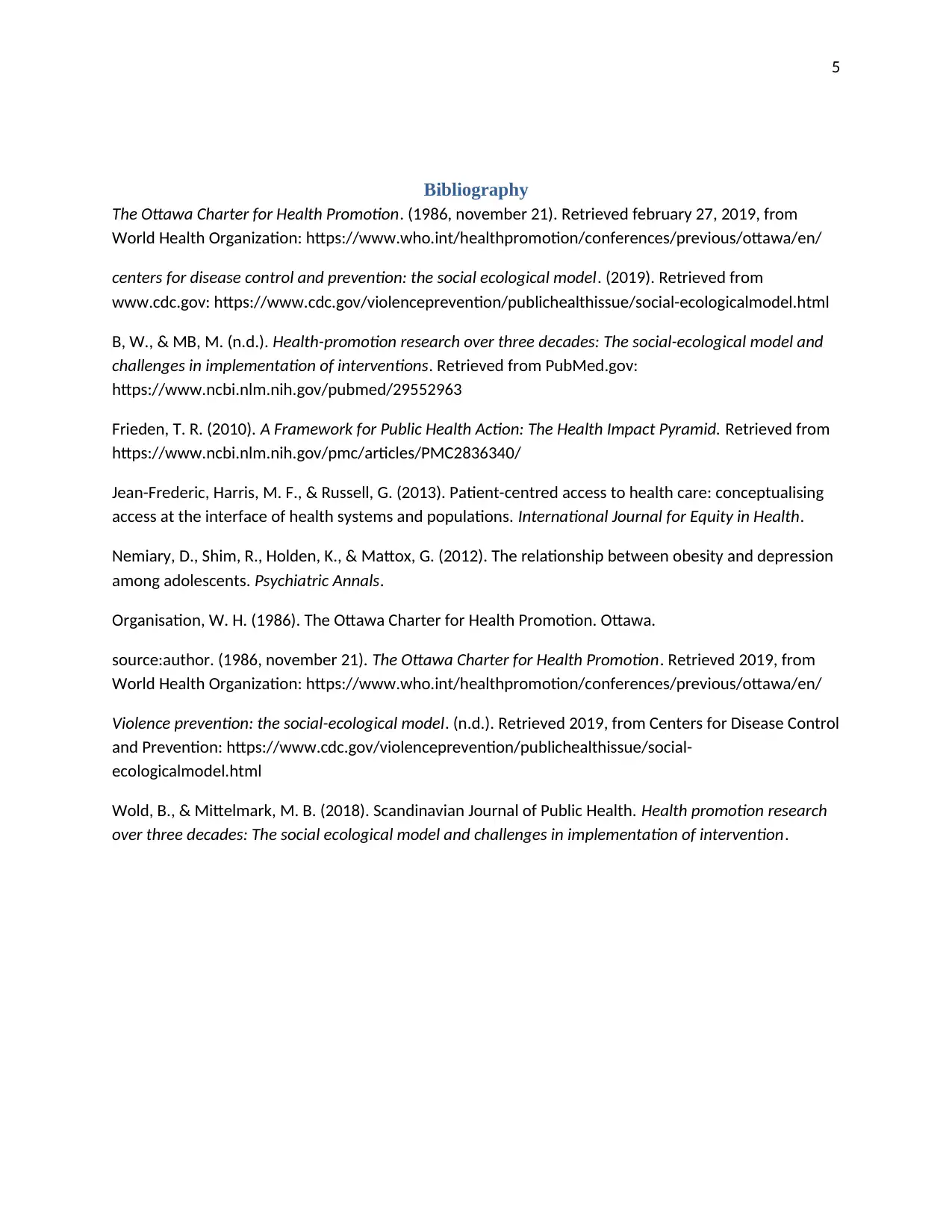
5
Bibliography
The Ottawa Charter for Health Promotion. (1986, november 21). Retrieved february 27, 2019, from
World Health Organization: https://www.who.int/healthpromotion/conferences/previous/ottawa/en/
centers for disease control and prevention: the social ecological model. (2019). Retrieved from
www.cdc.gov: https://www.cdc.gov/violenceprevention/publichealthissue/social-ecologicalmodel.html
B, W., & MB, M. (n.d.). Health-promotion research over three decades: The social-ecological model and
challenges in implementation of interventions. Retrieved from PubMed.gov:
https://www.ncbi.nlm.nih.gov/pubmed/29552963
Frieden, T. R. (2010). A Framework for Public Health Action: The Health Impact Pyramid. Retrieved from
https://www.ncbi.nlm.nih.gov/pmc/articles/PMC2836340/
Jean-Frederic, Harris, M. F., & Russell, G. (2013). Patient-centred access to health care: conceptualising
access at the interface of health systems and populations. International Journal for Equity in Health.
Nemiary, D., Shim, R., Holden, K., & Mattox, G. (2012). The relationship between obesity and depression
among adolescents. Psychiatric Annals.
Organisation, W. H. (1986). The Ottawa Charter for Health Promotion. Ottawa.
source:author. (1986, november 21). The Ottawa Charter for Health Promotion. Retrieved 2019, from
World Health Organization: https://www.who.int/healthpromotion/conferences/previous/ottawa/en/
Violence prevention: the social-ecological model. (n.d.). Retrieved 2019, from Centers for Disease Control
and Prevention: https://www.cdc.gov/violenceprevention/publichealthissue/social-
ecologicalmodel.html
Wold, B., & Mittelmark, M. B. (2018). Scandinavian Journal of Public Health. Health promotion research
over three decades: The social ecological model and challenges in implementation of intervention.
Bibliography
The Ottawa Charter for Health Promotion. (1986, november 21). Retrieved february 27, 2019, from
World Health Organization: https://www.who.int/healthpromotion/conferences/previous/ottawa/en/
centers for disease control and prevention: the social ecological model. (2019). Retrieved from
www.cdc.gov: https://www.cdc.gov/violenceprevention/publichealthissue/social-ecologicalmodel.html
B, W., & MB, M. (n.d.). Health-promotion research over three decades: The social-ecological model and
challenges in implementation of interventions. Retrieved from PubMed.gov:
https://www.ncbi.nlm.nih.gov/pubmed/29552963
Frieden, T. R. (2010). A Framework for Public Health Action: The Health Impact Pyramid. Retrieved from
https://www.ncbi.nlm.nih.gov/pmc/articles/PMC2836340/
Jean-Frederic, Harris, M. F., & Russell, G. (2013). Patient-centred access to health care: conceptualising
access at the interface of health systems and populations. International Journal for Equity in Health.
Nemiary, D., Shim, R., Holden, K., & Mattox, G. (2012). The relationship between obesity and depression
among adolescents. Psychiatric Annals.
Organisation, W. H. (1986). The Ottawa Charter for Health Promotion. Ottawa.
source:author. (1986, november 21). The Ottawa Charter for Health Promotion. Retrieved 2019, from
World Health Organization: https://www.who.int/healthpromotion/conferences/previous/ottawa/en/
Violence prevention: the social-ecological model. (n.d.). Retrieved 2019, from Centers for Disease Control
and Prevention: https://www.cdc.gov/violenceprevention/publichealthissue/social-
ecologicalmodel.html
Wold, B., & Mittelmark, M. B. (2018). Scandinavian Journal of Public Health. Health promotion research
over three decades: The social ecological model and challenges in implementation of intervention.
⊘ This is a preview!⊘
Do you want full access?
Subscribe today to unlock all pages.

Trusted by 1+ million students worldwide
1 out of 6
Related Documents
Your All-in-One AI-Powered Toolkit for Academic Success.
+13062052269
info@desklib.com
Available 24*7 on WhatsApp / Email
![[object Object]](/_next/static/media/star-bottom.7253800d.svg)
Unlock your academic potential
Copyright © 2020–2025 A2Z Services. All Rights Reserved. Developed and managed by ZUCOL.





